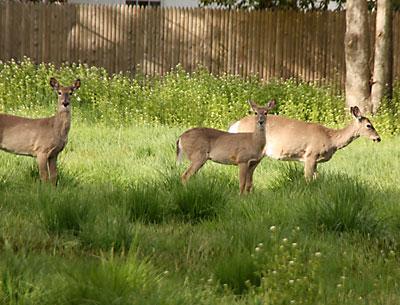Deer Are Now a ‘Dire Emergency’

Deer in the twilight at the side of the road. Deer dashing across the yellow lines, causing drivers to swerve and hit the brakes. Deer in the yard stripping the leaves off nurtured ornamentals. Deer staring up brazenly from a meal of just-planted pansies. Herds of deer cruising through farmers’ fields, wreaking havoc on tender crops.
Deer causing accidents and carrying ticks that make people sick with Lyme disease, babesiosis, ehrlichiosis.
Too many deer, most residents seem to agree. For several years, people have been imploring the East Hampton Town Board to take some kind of action on the burgeoning problem.
After holding a “deer summit” in 2010, the board asked its nature preserve committee to make recommendations regarding deer management on town properties. To continue the effort, a deer management working group was formed, under Councilman Dominick Stanzione’s direction.
“We are in a deer emergency situation,” he told the town board on Tuesday. “The public health of the people is at stake.” During a board work session, Mr. Stanzione reviewed a draft committee report that could form the basis for a comprehensive deer-management plan.
Collisions between vehicles and deer are increasing, he said, as are instances of tick-borne diseases, and damage to their property is prompting more and more homeowners to install deer fences — which, according to the committee’s report, “are making an unmistakable negative impact on the character of our community.”
Among the suggestions in the report, he said, are allowing an incremental increase in hunting and, possibly, an “emergency” culling through targeted hunting, with an eye toward reducing the number of deer by half within five years “to an ecologically and culturally sustainable level.” Nonlethal methods, such as fertility control, should also be implemented, Mr. Stanzione said.
The management committee, he said, tried to incorporate different views, including those of persons opposed to hunting, who, he said, “in the past, may have had an impact on boards not acting” decisively on the deer problem.
Other recommendations include developing a multi-town regional approach, creating an established budget line for the management program, and pursuing grants and other sources of funding.
The committee made several specific recommendations, among them opening more lands to hunters, including nonresidents; creating a nuisance deer hotline, and revising deer-fencing regulations. An essential first step, it said, would be to obtain a reliable estimate of the deer population, which could be consulted as time goes on to gauge the effectiveness of deer-control efforts. The committee recommended an aerial survey using infrared cameras to count the herds.
That process, and follow-up observations on the ground, noted Marguerite Wolffsohn, the town planning director, at Tuesday’s meeting, would provide not only a population estimate but information critical to planning a successful campaign by sharpshooters, such as data about the location and movements of the herd.
Coordination among the various entities that own and manage open land in East Hampton is also a key element, said Councilman Stanzione.
“Local preserved and native ecosystems have incurred some of the most significant environmental damage,” according to the report. “The drastic negative environmental impacts to the forest understory and the ecology of non-forest habitats also damage populations of other wildlife.”
“The absence of any coordination across land management constituencies has contributed to the damaging growth in the deer population. Any plan must address this issue,” it adds.
Councilwoman Theresa Quigley expressed impatience at Tuesday’s meeting, saying that, with the number of deer she sees while driving around East Hampton, the town should act immediately. “I really don’t understand what the plan is,” she said.
She repeatedly pressed for more specifics. Mr. Stanzione explained that the draft report contains the committee’s recommendations, as well as options for the board to consider.
Rather than review elements of the plan, Ms. Quigley said, “I would rather just say ‘go for it.’ ”
Mr. Stanzione responded that “We have legal obligations and processes to go through before we can begin.” Any deer management plan, he said, must be adopted following New York State Environmental Quality Review Act procedures, with a full review and public hearing required, as well as approval by the Department of Environmental Conservation, before it can be put into place. Once adopted, it can become part of the official town comprehensive plan.
“[The draft report] is the basis for a final plan,” the councilman said. “The preliminary work this body did is going to save us an enormous amount of time as we move forward.”
He thanked the 30 members of the committee, who, he said, “dealt honestly and earnestly with all the key issues dealing with deer, and came to a consensus” as to what to recommend.
The committee members included State Senator Kenneth J. LaValle, Assemblyman Fred W. Thiele Jr., County Legislator Jay Schneiderman, and representatives from groups such as the D.E.C., the Group for the East End, the East Hampton Group for Wildlife, East Hampton Sportsmen’s Alliance, and the state and county parks departments
“I think when you read through it, Theresa, you’ll find it’s mostly recommendations,” Mr. Stanzione told Ms. Quigley on Tuesday. “And the decisions — the committee wants the best, but it costs more, and the board has to make the decision. It’ll make sense once you read it.”
At a work session on Tuesday, after the board reviews the report, it is expected to be the subject of discussion. It will be posted on the town’s Web site, town.east-hampton.ny.us, Ms. Wolffsohn said, for public review.
